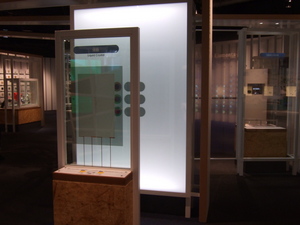Nagoya City Science Museum
TOP > Exhibition Guide > Keyword Search > Starting with "M" > Metal > Liquid Crystal
Liquid Crystal



Purpose of Exhibition
Liquid crystals are widely used in display screens such as LCD TVs, mobile phones, personal computers, and digital clocks, etc. Everyone knows liquid crystal well, don't they?But what are these "liquid crystals"?When a usual material is in a solid state, molecules and atoms are in regular alignment arranged as crystals. And when they are in an irregular arrangement, there is liquidity.
However, in exceptional circumstances, there is a substance which contains molecules in an aligned direction, while still maintaining liquidity as fluid; that eccentric substance is "liquid crystal".
Additional Knowledge
[Liquid Crystal Discovery]
An Austrian botanist F. Reinitzer realized that when heating a cholesterol and benzoic acid ester compound, the liquid becomes cloudy, and when raising the temperature, it becomes transparent again. This was the discovery of liquid crystals (1888).
According to subsequent studies, in the sense of an intermediate state between liquid and crystal, it was named "liquid crystal".
Many substances considered similar to liquid crystal were discovered, and they have a point in common. Their molecules have an elongated rod-like shape, and an easy-to-align orientation.
Also, those molecules move easily according to voltage, magnetic force, etc., and the path of light changes. If cooled down, liquid crystal becomes solid crystal and it becomes a clear liquid in raised temperatures.
It is in its specific state called liquid crystal only within a certain temperature range.
[Liquid Crystal that changes color according to temperature]
There are liquid crystals in which color changes according to temperature. This is a "cholesteric liquid crystal" type. It has a helical arrangement of the liquid crystal molecules, and has the property to reflect light with certain colors depending on the temperature.
There is a lot of cholesterol within squids, whose cholesterol is extracted from a squid lever and processed to fabricate liquid crystal. (Currently, it is fabricated by synthesis).
It is used in card type thermometers etc. (liquid crystal thermometers on which numbers in red, green and purple are shown with black background).
[Liquid Crystal Used in Display Screens]
Most computer screens (liquid crystal panels) use a "nematic liquid crystal".
Nematic liquid crystal molecules are rod-shaped; these have a positive charged part and a negative charged part. When applying voltage to a regularly sorted nematic liquid crystal, it changes its direction.
Most liquid crystal panels have a sandwich structure of two polarized liquid crystal plates.
A polarizing plate penetrates only light vibrating at a fixed direction (polarized light). Setting one polarizing plate on the other plate, making one rotate, they become bright and dark. If the two polarized plates have the same direction as the vibration of the light that penetrates, they become clear, and in the case of a deviation of 90 degrees, they become dark.
If you don't rotate the polarized plates and insert liquid crystal between them, what becomes of it? Depending on how the liquid crystal molecules are arranged, there are cases when light penetrates and cases when it does not. The orientation of the liquid crystal molecules causes either case. When applying voltage, the orientation of the liquid crystal molecules changes, therefore, the ease of light penetration changes as well.
By varying the voltage, lightening and darkening of light occurs, and text and images are displayed. Through red, green and blue filters, the penetrating light becomes color images.
Furthermore, by not using polarized plates, but by using cholesteric liquid crystal instead, "electronic paper" has been developed.
Article by Keiko Ishida, curator
